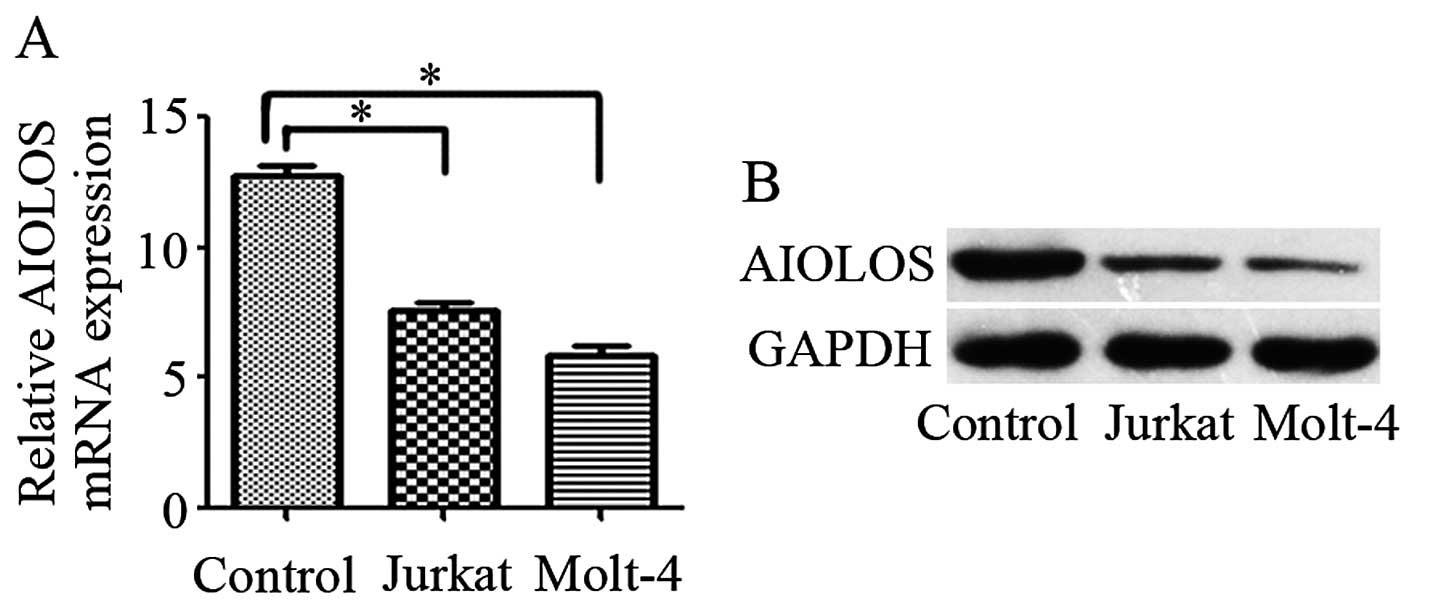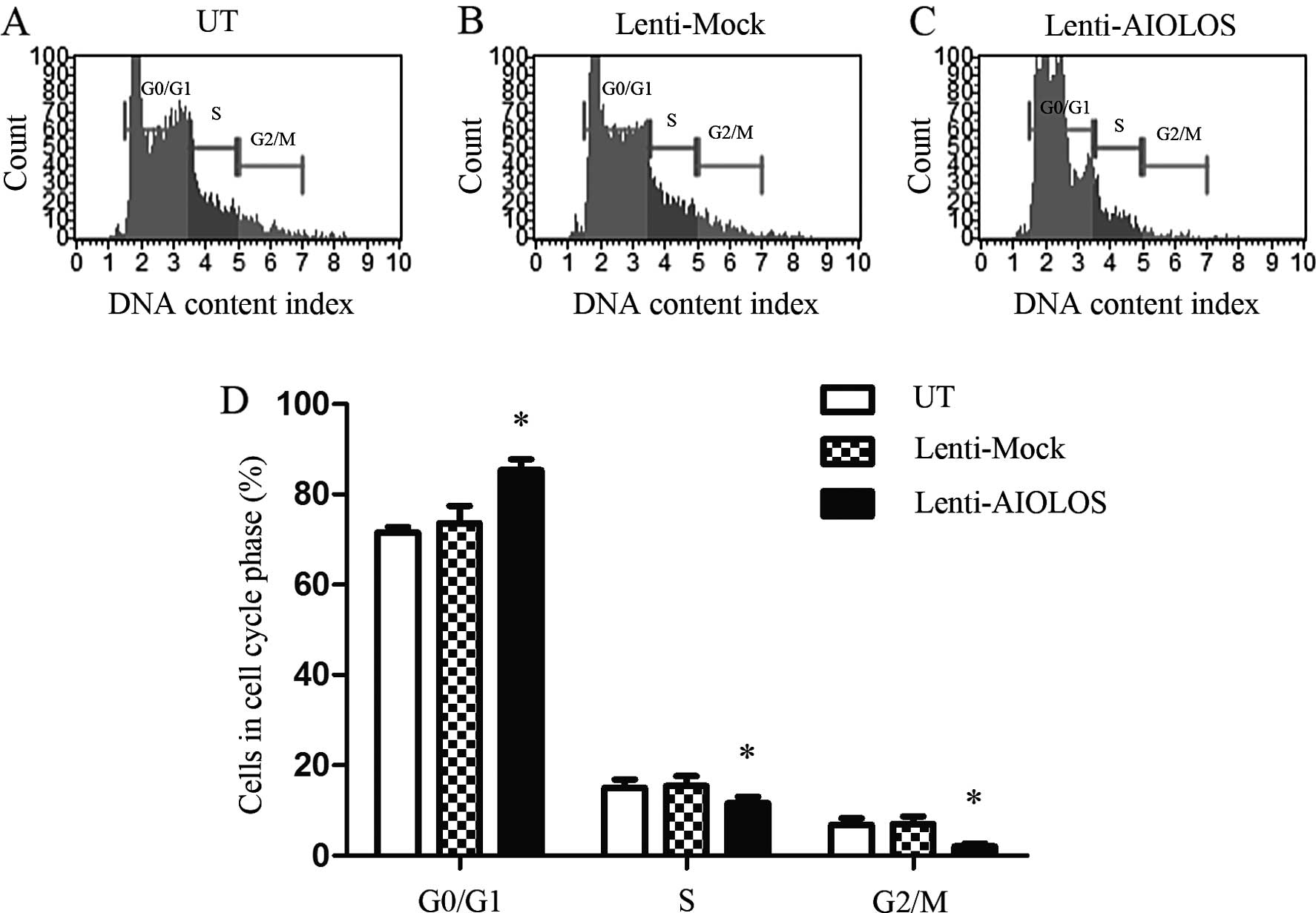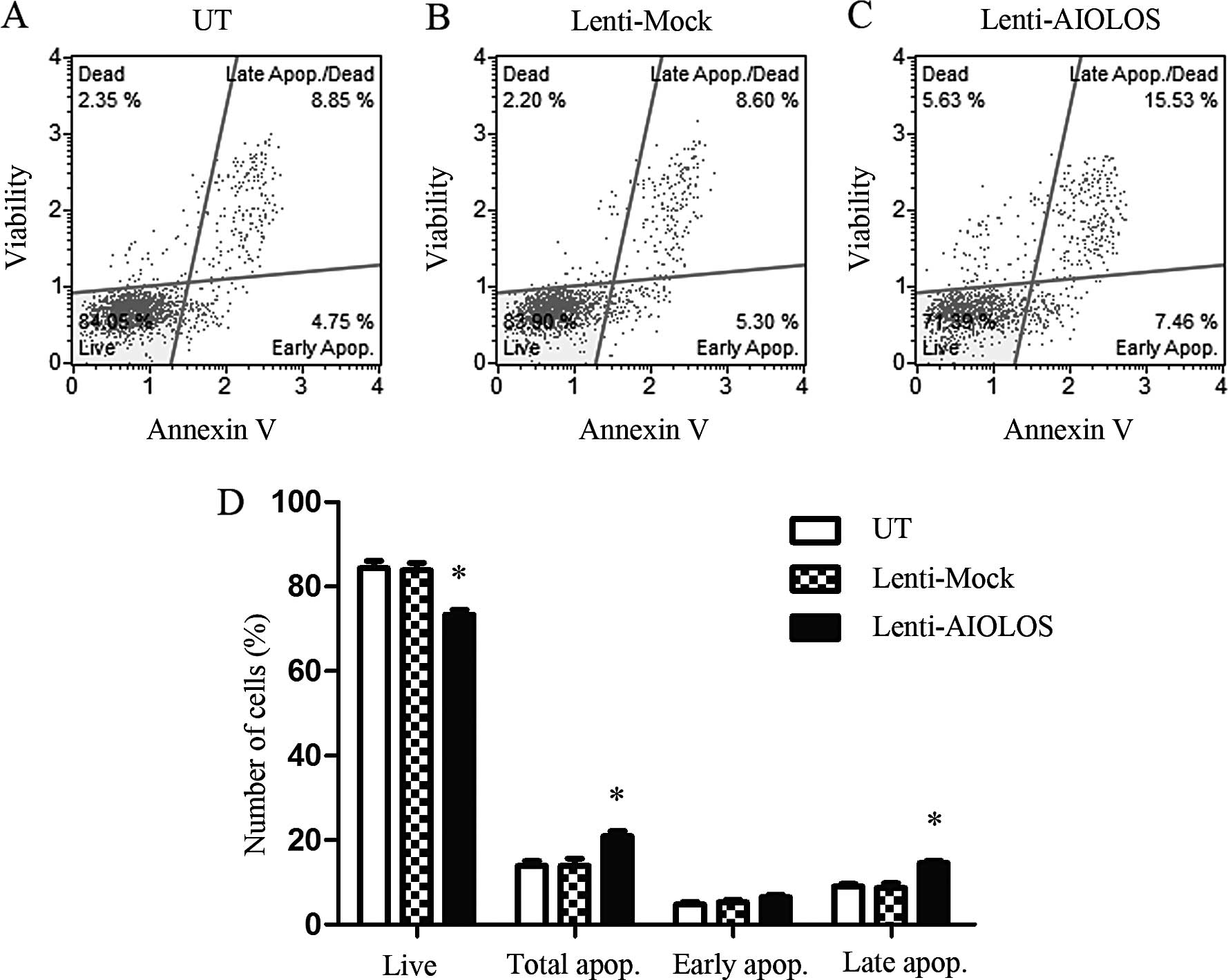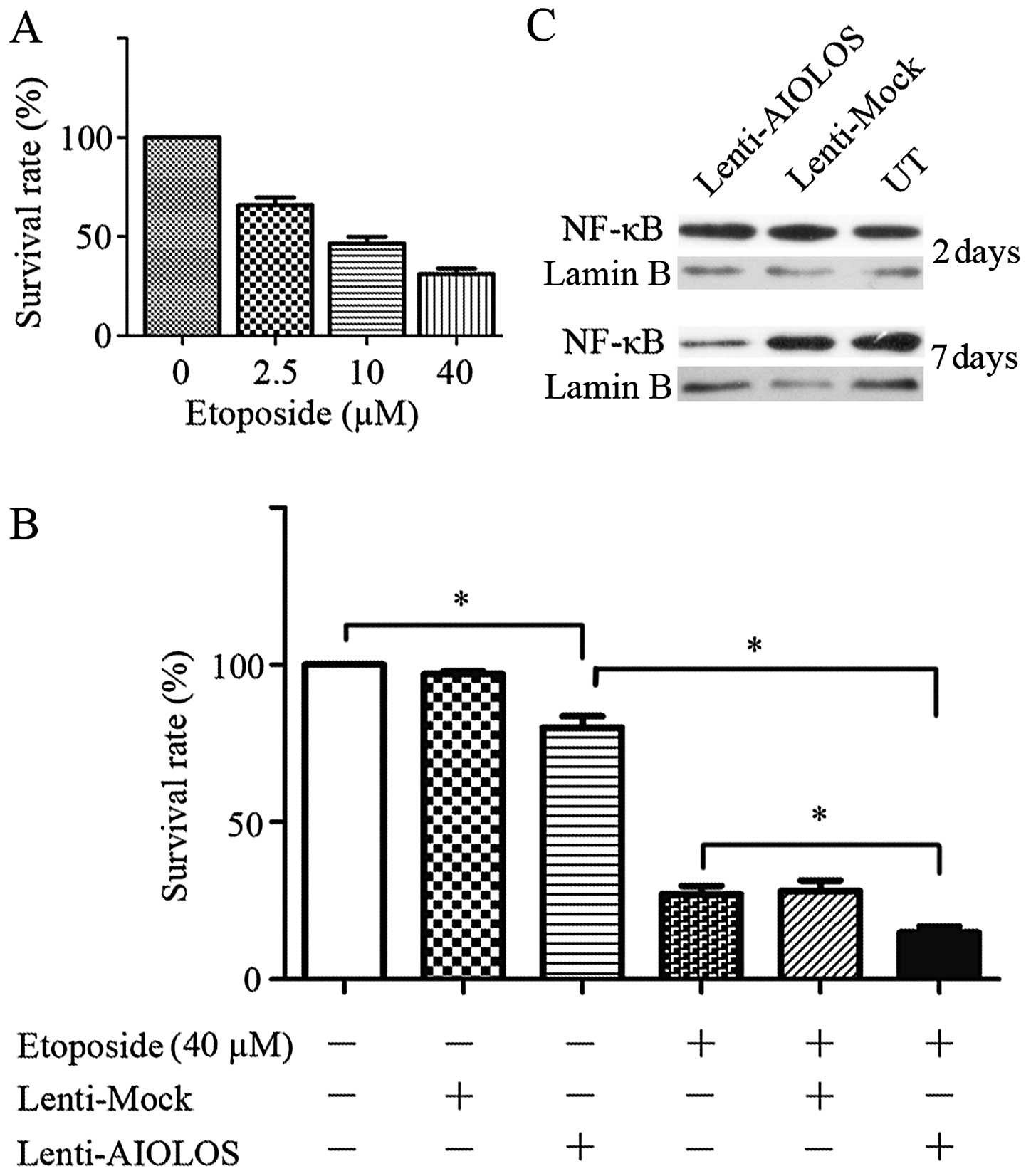Upregulation of AIOLOS induces apoptosis and enhances etoposide chemosensitivity in Jurkat leukemia cells
- Authors:
- Published online on: December 18, 2014 https://doi.org/10.3892/or.2014.3677
- Pages: 1319-1325
Abstract
Introduction
Acute lymphoblastic leukemia (ALL), which can be divided into B-lineage ALL (B-ALL) and T-lineage ALL (T-ALL) (1), is one of the most common forms of pediatric malignancies originating from lymphoid precursors (2). T-ALL accounts for 10 to 15% of pediatric cases and 25% of adult ALL cases (3). With current intensified multi-agent chemotherapy protocols, the 5-year event-free survival (EFS) of children with T-ALL has reached 70–75% (4). However, these therapies are highly toxic. Moreover, relapsed patients often develop resistance to chemotherapy and experience very poor prognosis (5). Therefore, the mechanisms that cause relapses and chemo-resistance in T-ALL should be understood to identify novel molecular targets and design effective therapies.
T-ALL is an aggressive blood malignancy originating from T-cell progenitors in the thymus. Genes encoding transcriptional regulators of T-cell development and maturation are potential targets of T-ALL therapy. The IKAROS family, an important group of transcription factors in hematopoietic lineages, encodes a group of zinc-finger DNA-binding proteins essential for normal lymphocyte development (6–8). AIOLOS is an IKAROS family member that was first described in committed lymphoid progenitors and was strongly upregulated as these progenitors become restricted into T- and B-lymphoid pathways (7). Previous studies have shown that AIOLOS controls T and B lymphocyte apoptosis by regulating Bcl-xL (9,10) and also regulates cell death in T cells by controlling Bcl-2 expression and cellular localization (11). Deregulated AIOLOS expression has been associated with leukemia and lymphoma in human patients (12–15).
In the present study, a lentiviral system was used to stably overexpress the AIOLOS gene in Jurkat cells, a T-ALL cell line, and to examine apoptosis, cell cycle distribution and cell chemosensitivity to etoposide in vitro. Our results demonstrated that AIOLOS overexpression in Jurkat cells induced cell apoptosis, arrested the cell cycle at the G0/G1 phase, and synergistically increased the sensitivity of Jurkat cells to etoposide by inhibiting NF-κB activity.
Materials and methods
Cell lines and cell culture
Two T-ALL cell lines (Jurkat and Molt-4) were purchased from the American Type Culture Collection (ATCC; Manassas, VA, USA) and cultured in standard culture medium [RPMI-1640 containing 10% fetal bovine serum (FBS) and 1% penicillin-streptomycin (all from Gibco, Grand Island, NY, USA)] at 37°C in 5% CO2 in air. The cells were subcultured after 24–48 h with an initial concentration of 4×104 cells/ml and were used at the logarithmic phase in all of the experiments. Peripheral blood lymphocytes collected from consenting normal healthy children were used as control cells. The experimental design and protocols were approved by the Ethics Committee of Qilu Hospital. Informed consent was obtained for all participants prior to enrollment.
Lentiviral vector construction, virus production and transfection
The lentiviral vectors pWPT-PURO-GFP-AIOLOS (Lenti-AIOLOS) and pWPT-PURO-GFP (Lenti-Mock) were constructed and identified as previously described (16). Viral concentrate was diluted in Polybrene (5 μg/ml; Sigma, St. Louis, MO, USA) to infect Jurkat cells at a multiplicity of infection (MOI) of 100. Successful transduction was confirmed by visualizing enhanced green fluorescent protein (EGFP; included in the pWPT-PURO-GFP vector) after 4 days. The cells were maintained and allowed to grow for another 3–5 days; the AIOLOS expression level was confirmed by qRT-PCR and western blot analysis. Virus-infected cells were selected with 8 μg/ml puromycin (Invitrogen, Carlsbad, CA, USA). Antibiotic-resistant clones were pooled and used for subsequent assays.
Jurkat cells were divided into three groups: untransfected (UT) control, lentiviral vector control (Lenti-Mock) and AIOLOS-transfected (Lenti-AIOLOS) groups.
Quantitative real-time reverse-transcription polymerase chain reaction
Total RNA was extracted from Jurkat cells of the three groups by using TRIzol reagent (Invitrogen). To perform reverse transcription (RT), we synthesized first-strand cDNA from 5 μg of total RNA using the Omniscript cDNA synthesis kit (Qiagen, Hamburg, Germany) according to the manufacturer’s instructions. PCR was performed using 2 μl of 10-fold diluted cDNA.
cDNA samples were analyzed by qRT-PCR in an Applied Biosystems 7500 PCR system (Applied Biosystems, Foster City, CA, USA) with SYBR-Green I dye (Toyobo, Osaka, Japan). Primers (Table I) were obtained from Bioasi Co., Ltd., Shanghai, China. Data were analyzed using the 2−Δ ΔCt method, where ΔCt = (Cttarget gene − Ctβ-actin), to obtain the relative expression level. Each sample was then normalized using β-actin expression. Results are expressed as fold change relative to the cDNA of the UT group. Data were also analyzed using Sequence Detection Software 1.4 (Applied Biosystems). Reported data are representative of at least three independent experiments.
Protein extraction and western blot analysis
Jurkat cells were harvested and washed twice with cold phosphate-buffered saline (PBS). Total and nuclear protein fractions were extracted using RIPA lysis buffer and nuclear and cytoplasmic protein extraction kit (both from Beyotime Institute of Biotechnology, Jiangsu, China), respectively, according to the manufacturer’s protocols. Total AIOLOS and nuclear NF-κB expression levels were analyzed. The proteins were quantified using the Bradford protein assay kit (Beyotime Institute of Biotechnology). Equal amounts of proteins were loaded in each well of 12% sodium dodecyl sulfate-polyacrylamide gels and transferred to polyvinylidene fluoride microporous membranes (Millipore, Bedford, MA, USA). Membranes containing the transferred proteins were blocked with PBS containing 0.1% Tween-20 (PBS-T) and 5% skim milk for 1 h at room temperature. After three washes with PBS-T, the membranes were incubated with antibodies against AIOLOS (1:1,000), NF-κB (1:1,000), GAPDH (1:1,000) or lamin B (1:1,000) (all from Abcam Inc., Cambridge, MA, USA) at 4°C overnight. After three washes with PBS-T, the membranes were incubated with horseradish peroxidase-conjugated secondary antibodies (1:1,000; Beyotime Institute of Biotechnology) for 1 h at room temperature. After three final washes in PBS-T and two in PBS, chemiluminescence was detected using an ECL Plus immunoblotting detection system (Beyotime Institute of Biotechnology).
Cell cycle and apoptosis assay
Jurkat cells were obtained 9 days after transfection; cell cycle and apoptosis were detected using a Muse™ cell cycle reagent, Muse™ Annexin V and a dead cell kit (all from Millipore) according to the manufacturer’s instructions. Assay results were obtained using a Muse™ cell analyzer (Millipore). Cell cycle results are expressed as the percentage of cells in each cell cycle phase. Cell apoptosis results are expressed as the percentage of apoptotic cells. Error bars represent standard errors of the means (SEM).
Cytotoxicity assay
The effect of AIOLOS overexpression on the sensitivity of the Jurkat cell line to etoposide (Sigma, St. Louis, MO, USA) was evaluated using the CCK-8 (Beyotime Institute of Biotechnology, Haimen, China) assay. The experiment was divided into six groups: etoposide, Lenti-AIOLOS, Lenti-Mock, Lenti-AIOLOS and etoposide, Lenti-Mock and etoposide and etoposide blank control. The cells treated with only 0.9% NS were used as etoposide blank controls. In brief, the cells were cultivated at a density of 2×104 cells/well in 96-well culture plates. At 96 h after transfection, the cells were treated with various concentrations of etoposide (0, 2.5, 10 and 40 μM). After 48 h of culture, the cytotoxicity of the treatments was determined using WST-8 dye (Beyotime Institute of Biotechnology) according to the manufacturer’s instructions. The generated formazan was determined using a Model 450 microplate reader (Bio-Rad Laboratories, Richmond, CA, USA) at an optical density of 570 nm (OD570) to determine cell viability. Survival rate (SR) was calculated using the following equation: SR (%) = (A Test/A Control) × 100%, where A is the absorbance value.
Statistical analysis
All of the experiments were performed at least thrice. Prism 5.0 (GraphPad Software) was used for statistical analysis. P-values were obtained from two-tailed tests and were considered to indicate a statistically significant result at P<0.05.
Results
AIOLOS protein expression in the Jurkat cells is lower than that in normal child peripheral blood lymphocytes
To evaluate whether or not aberrant AIOLOS expression is observed in T-ALL, we quantified AIOLOS expression levels by qRT-PCR and western blot analysis in the T-ALL cell lines and normal child peripheral blood lymphocytes. The mRNA levels of AIOLOS were lower in both T-ALL cell lines than the levels in the normal control (P<0.05; Fig. 1A). Western blot analysis results were consistent with those of qRT-PCR (Fig. 1B). The Jurkat cell line was chosen for a series of functional experiments.
AIOLOS is overexpressed by stable transfection in Jurkat cells
The Jurkat cells were infected with the lentiviral vector pWPT-PURO-GFP-AIOLOS. As a control sample, the Jurkat cells were either infected with a lentiviral vector expressing GFP or not. At 96 h after the Jurkat cells were infected, infection efficiency was detected using a fluorescence microscope. More than 90% of the cells emitted bright green fluorescence, which represented high infection efficiency (Fig. 2A–F). Cells were maintained and allowed to grow for 3–5 days. The mRNA and protein expression levels of AIOLOS in the Jurkat cells of the three groups were determined by qRT-PCR and western blot analysis at 7 days after infection. qRT-PCR results demonstrated that the mRNA expression level of AIOLOS in the Jurkat cells of the Lenti-AIOLOS group was markedly increased compared with that of the Lenti-Mock and the UT group. This finding was consistent with the increase in AIOLOS protein expression (Fig. 2G and H). No significant difference between the cells of the Lenti-Mock and the UT group was observed. These results revealed that the stable transfection of pWPT-PURO-GFP-AIOLOS upregulated AIOLOS expression in the Jurkat cells.
AIOLOS overexpression arrests the cell cycle in the G1 phase in Jurkat cells
The cell cycle distribution of the Jurkat cells in the Lenti-AIOLOS, Lenti-Mock and UT groups was characterized by fluorescence-activated cell sorting (FACS) analysis 9 days after transfection. The percentage of Jurkat cells in the G0/G1 phase increased from 71.5 (UT) to 85.4% (Lenti-AIOLOS; P<0.05; Fig. 3), and the percentage of S-phase cells was decreased from 15.1 (UT) to 11.6% (Lenti-AIOLOS; P<0.05). The difference between Jurkat cells of the Lenti-AIOLOS and the UT group in the G2/M phase was significant (2.0 vs. 6.8%; P<0.05). No significant difference between the Lenti-Mock and the UT Jurkat cells was observed (P>0.05). These data revealed that the upregulation of AIOLOS expression arrested Jurkat cells at the G0/G1 phase.
AIOLOS overexpression induces apoptosis in Jurkat cells
To determine whether or not AIOLOS overexpression results in apoptosis in the Jurkat cells, we used the Muse™ Annexin V and the dead cell kit and determined the changes in cell apoptosis on day 9. The percentage of total apoptotic cells was significantly increased in the AIOLOS-transfected Jurkat cells (21.93%) compared with the percentage in the Lenti-Mock (13.35%) or UT group (13.30%; P<0.05; Fig. 4). In particular, the difference between AIOLOS-transfected Jurkat and UT Jurkat cells in regards to the percentage of early apoptotic cells was minimal (6.46 vs. 4.81%; P>0.05). The difference between the cell groups in regards to the percentage of late apoptotic cells was significant (14.55 vs. 9.05%; P<0.05). These data revealed that AIOLOS overexpression suppressed cell apoptosis in the Jurkat cells.
AIOLOS affects the expression levels of apoptosis- and cell cycle-related genes in Jurkat cells
To investigate the mechanism by which AIOLOS blocks the cell cycle and promotes the apoptosis of Jurkat cells, we examined the expression of genes associated with apoptosis and the cell cycle in response to AIOLOS overexpression by performing qRT-PCR (Fig. 5). The mRNA expression levels of P21 and P27 were significantly increased in the AIOLOS-transfected Jurkat cells compared with these levels in the UT and Lenti-Mock Jurkat cells (Fig. 5); this result was consistent with that of the cell cycle assay. In addition, CCND3, one of the known cell cycle-related genes and SKP2, a typical representative of cell cycle negative regulators, were downregulated in the AIOLOS-transfected Jurkat cells. Furthermore, BCL-2 expression in the Lenti-AIOLOS group was significantly decreased (P<0.05). No distinct changes were detected in BAX (P>0.05).
AIOLOS overexpression synergistically increases the sensitivity of Jurkat cells to etoposide by inhibiting NF-κB activity
To analyze whether or not increased AIOLOS expression can enhance the sensitivity of Jurkat cells to etoposide, we performed a combined treatment of Lenti-AIOLOS and etoposide. Single treatment with etoposide induced cytotoxicity in a dose-dependent manner (Fig. 6A). Thus, 40 μM etoposide was chosen for further experiments. The results showed that Lenti-AIOLOS alone significantly lowered the cell SR to 80.07% when compared with the blank control (P<0.05). As shown in Fig. 6B, combined therapy further reduced the cell SR compared with Lenti-AIOLOS or etoposide monotreatment (P<0.05). Lenti-Mock affected the chemosensitivity of the cells compared with etoposide alone, yet this effect was not significant (P>0.05). To explore the mechanism of the observed synergistic cytotoxic effects between Lenti-AIOLOS and etoposide, we investigated NF-κB expression since this transcription factor is involved in several pathways and broadly regulates targets in cancer. Fig. 6C shows that NF-κB expression decreased as AIOLOS was overexpressed in the Jurkat cells.
Discussion
As a member of the IKAROS family of zinc-finger proteins, the AIOLOS transcription factor, encoded by the IKZF3 gene, is necessary to control lymphocyte differentiation, proliferation and maturation. Thus, the T-ALL cell line Jurkat was chosen for a series of functional studies to explore the function of AIOLOS in the pathogenesis of T-ALL. To mimic the isoforms and cellular localizations of AIOLOS in T-cells, we constructed a plasmid pWPT-PURO-GFP-AIOLOS containing the entire AIOLOS coding sequence and performed lentiviral-mediated transduction in Jurkat cells to create a stable transfection cell line. qRT-PCR and western blot analysis revealed that Lenti-AIOLOS treatment caused a constant increase in AIOLOS expression at the mRNA and protein levels for 4 days. These results revealed that the Jurkat cells were successfully transduced with the lentivirus, and AIOLOS was successfully overexpressed in Jurkat cells.
Cell cycle assay results indicated that AIOLOS overexpression arrested the cell cycle of the Lenti-AIOLOS cells at the G0/G1 phase. To explore the potential mechanisms of AIOLOS in the Jurkat cell cycle, we analyzed the expression of cell cycle-related genes, including P21, P27, CCND3 and SKP2 by qRT-PCR. Skp2 functions as an oncoprotein, participates in many aspects of cancer progression by inducing p27 and p21 degradation (17,18), and establishes a crosstalk with other major signaling pathways (19–21). A previous study reported that activation of the JAK2/STAT3 pathway enhanced leukemogenesis (22). In addition, JAK2/STAT3 pathway inhibition was found to upregulate p27 and p21 expression (23). Consistent with these results, our findings showed that AIOLOS overexpression upregulated p27 and p21 expression and downregulated Skp2. This result revealed that AIOLOS may interact with the Skp2/p27/p21 pathway via JAK2/STAT3 signaling in Jurkat leukemia cells.
AIOLOS reportedly controls T-cell death by regulating the expression and localization of the anti-apoptotic molecule Bcl-2 (11), suggesting the possibility that apoptotic cell death evasion is a common mechanism by which IKAROS family proteins participate in leukemogenesis. In the present study, AIOLOS overexpression in Jurkat cells induced cell apoptosis. Considering that Bcl-2 family proteins play a critical role as promoters or inhibitors in the regulation of apoptosis (24), we investigated whether or not the disruption of apoptosis-related genes BCL-2 and BAX contributes to apoptosis induction of Jurkat cells by AIOLOS overexpression. Although no distinct changes were found in BAX, BCL-2 was downregulated, resulting in a low BCL-2/BAX ratio, which may be a possible reason for the increased apoptosis in the Jurkat cells. However, further research is required to explore the complete mechanism.
Cell cycle and apoptosis assay results indicated that AIOLOS overexpression may play a critical role in drug resistance of leukemia cells. CCK-8 assay results showed that Lenti-AIOLOS pretreatment synergistically increased the cytotoxic effect of etoposide. This finding revealed that AIOLOS overexpression could sensitize leukemia cells in response to etoposide. Etoposide is a DNA topoisomerase II inhibitor commonly used to treat several malignancies, including leukemia. The exposure of leukemia cells to etoposide initiates both signaling pathways of apoptosis by activating multiple caspases (25,26). T-ALL is associated with NF-κB pathway activation, an important regulator of cell survival, proliferation and differentiation (27). Moreover, NF-κB expression was found to decrease after AIOLOS was overexpressed in B-ALL (16). Our initial hypothesis was that the synergism of AIOLOS on the effects of etoposide was probably related to the inhibition of basal NF-κB activity. To test this hypothesis, we performed immunoblotting experiments for nuclear NF-κB activity. As expected, the results of such experiments clearly indicated that AIOLOS overexpression indeed inhibited NF-κB activity in Jurkat cells. Therefore, AIOLOS overexpression may sensitize leukemia cells to etoposide by inhibiting NF-κB activity. Further studies should be conducted to verify this conclusion.
In summary, the present study is the first to explore the function of the transcription factor AIOLOS in regards to the biological behaviors of a human T-ALL cell line. The present study provides the basis for further research on the pathogenesis of T-ALL. Our results revealed that the upregulation of AIOLOS expression in Jurkat cells induced cell apoptosis and arrested the cell cycle at the G0/G1 phase. In addition, AIOLOS overexpression synergistically increased the sensitivity of Jurkat cells to etoposide by inhibiting NF-κB activity. However, the mechanism by which AIOLOS interacts with other regulators remains poorly understood. These potential genetic interactions should be characterized in future studies.
Acknowledgements
The present study was supported by Grants of the Shandong Province Natural Science Foundation (ZR2011HM007 and 2013GSF11812), the Innovation Fund Project of Shandong University (2014QY003-11), and the Scientific Research Fund of Shenzhen (JCYJ20140418115449178).
References
|
Chiaretti S and Foà R: T-cell acute lymphoblastic leukemia. Haematologica. 94:160–162. 2009. View Article : Google Scholar : PubMed/NCBI | |
|
Pui CH, Robison LL and Look AT: Acute lymphoblastic leukaemia. Lancet. 371:1030–1043. 2008. View Article : Google Scholar : PubMed/NCBI | |
|
Ferrando AA, Neuberg DS, Staunton J, Loh ML, Huard C, Raimondi SC, Behm FG, Pui CH, Downing JR, Gilliland DG, Lander ES, Golub TR and Look AT: Gene expression signatures define novel oncogenic pathways in T cell acute lymphoblastic leukemia. Cancer Cell. 1:75–87. 2002. View Article : Google Scholar : PubMed/NCBI | |
|
Pui CH and Evans WE: Treatment of acute lymphoblastic leukemia. N Engl J Med. 354:166–178. 2006. View Article : Google Scholar : PubMed/NCBI | |
|
Bhojwani D and Pui CH: Relapsed childhood acute lymphoblastic leukaemia. Lancet Oncol. 14:e205–e217. 2013. View Article : Google Scholar : PubMed/NCBI | |
|
Kelley CM, Ikeda T, Koipally J, Avitahl N, Wu L, Georgopoulos K and Morgan BA: Helios, a novel dimerization partner of Ikaros expressed in the earliest hematopoietic progenitors. Curr Biol. 8:508–515. 1998. View Article : Google Scholar : PubMed/NCBI | |
|
Morgan B, Sun L, Avitahl N, Andrikopoulos K, Ikeda T, Gonzales E, Wu P, Neben S and Georgopoulos K: Aiolos, a lymphoid restricted transcription factor that interacts with Ikaros to regulate lymphocyte differentiation. EMBO J. 16:2004–2013. 1997. View Article : Google Scholar : PubMed/NCBI | |
|
Georgopoulos K, Winandy S and Avitahl N: The role of the Ikaros gene in lymphocyte development and homeostasis. Ann Rev Immunol. 15:155–176. 1997. View Article : Google Scholar | |
|
Narvi E, Nera KP, Terho P, Mustonen L, Granberg J and Lassila O: Aiolos controls gene conversion and cell death in DT40 B cells. Scand J Immunol. 65:503–513. 2007. View Article : Google Scholar : PubMed/NCBI | |
|
Rebollo A, Ayllón V, Fleischer A, Martínez CA and Zaballos A: The association of Aiolos transcription factor and Bcl-xL is involved in the control of apoptosis. J Immunol. 167:6366–6373. 2001. View Article : Google Scholar : PubMed/NCBI | |
|
Romero F, Martínez-A C, Camonis J and Rebollo A: Aiolos transcription factor controls cell death in T cells by regulating Bcl-2 expression and its cellular localization. EMBO J. 18:3419–3430. 1999. View Article : Google Scholar : PubMed/NCBI | |
|
Nakase K, Ishimaru F, Avitahl N, Dansako H, Matsuo K, Fujii K, Sezaki N, Nakayama H, Yano T, Fukuda S, Imajoh K, Takeuchi M, Miyata A, Hara M, Yasukawa M, Takahashi I, Taguchi H, Matsue K, Nakao S, Niho Y, Takenaka K, Shinagawa K, Ikeda K, Niiya K and Harada M: Dominant negative isoform of the Ikaros gene in patients with adult B-cell acute lymphoblastic leukemia. Cancer Res. 60:4062–4065. 2000.PubMed/NCBI | |
|
Nückel H, Frey UH, Sellmann L, Collins CH, Duhrsen U and Siffert W: The IKZF3 (Aiolos) transcription factor is highly upregulated and inversely correlated with clinical progression in chronic lymphocytic leukaemia. Br J Haematol. 144:268–270. 2009. View Article : Google Scholar | |
|
Billot K, Soeur J, Chereau F, Arrouss I, Merle-Beral H, Huang ME, Mazier D, Baud V and Rebollo A: Deregulation of Aiolos expression in chronic lymphocytic leukemia is associated with epigenetic modifications. Blood. 117:1917–1927. 2011. View Article : Google Scholar | |
|
Antica M, Cicin-Sain L, Kapitanovic S, Matulic M, Dzebro S and Dominis M: Aberrant Ikaros, Aiolos, and Helios expression in Hodgkin and non-Hodgkin lymphoma. Blood. 111:3296–3297. 2008. View Article : Google Scholar : PubMed/NCBI | |
|
Zhuang Y, Li D, Fu J, Shi Q, Lu Y and Ju X: Overexpression of AIOLOS inhibits cell proliferation and suppresses apoptosis in Nalm-6 cells. Oncol Rep. 31:1183–1190. 2014.PubMed/NCBI | |
|
Frescas D and Pagano M: Deregulated proteolysis by the F-box proteins SKP2 and β-TrCP: tipping the scales of cancer. Nat Rev Cancer. 8:438–449. 2008. View Article : Google Scholar : PubMed/NCBI | |
|
Hershko DD: Oncogenic properties and prognostic implications of the ubiquitin ligase Skp2 in cancer. Cancer. 112:1415–1424. 2008. View Article : Google Scholar : PubMed/NCBI | |
|
Wang Z, Fukushima H, Inuzuka H, Wan L, Liu P, Gao D, Sarkar FH and Wei W: Skp2 is a promising therapeutic target in breast cancer. Front Oncol. 1:pii: 18702. 2012. View Article : Google Scholar : PubMed/NCBI | |
|
Kitagawa M, Lee SH and McCormick F: Skp2 suppresses p53-dependent apoptosis by inhibiting p300. Mol Cell. 29:217–231. 2008. View Article : Google Scholar : PubMed/NCBI | |
|
Lin HK, Wang G, Chen Z, Teruya-Feldstein J, Liu Y, Chan CH, Yang WL, Erdjument-Bromage H, Nakayama KI, Nimer S, Tempst P and Pandolfi PP: Phosphorylation-dependent regulation of cytosolic localization and oncogenic function of Skp2 by Akt/PKB. Nat Cell Biol. 11:420–432. 2009. View Article : Google Scholar : PubMed/NCBI | |
|
Stella S, Tirrò E, Conte E, Stagno F, Di Raimondo F, Manzella L and Vigneri P: Suppression of survivin induced by a BCR-ABL/JAK2/STAT3 pathway sensitizes imatinib-resistant CML cells to different cytotoxic drugs. Mol Cancer Ther. 12:1085–1098. 2013. View Article : Google Scholar : PubMed/NCBI | |
|
Xiong H, Zhang ZG, Tian XQ, Sun DF, Liang QC, Zhang YJ, Lu R, Chen YX and Fang JY: Inhibition of JAK1, 2/STAT3 signaling induces apoptosis, cell cycle arrest, and reduces tumor cell invasion in colorectal cancer cells. Neoplasia. 10:287–297. 2008.PubMed/NCBI | |
|
Kirkin V, Joos S and Zörnig M: The role of Bcl-2 family members in tumorigenesis. Biochim Biophys Acta. 1644:229–249. 2004. View Article : Google Scholar : PubMed/NCBI | |
|
Martins LM, Mesner PW, Kottke TJ, Basi GS, Sinha S, Tung JS, Svingen PA, Madden BJ, Takahashi A, McCormick DJ, Earnshaw WC and Kaufmann SH: Comparison of caspase activation and subcellular localization in HL-60 and K562 cells undergoing etoposide-induced apoptosis. Blood. 90:4283–4296. 1997.PubMed/NCBI | |
|
Montecucco A and Biamonti G: Cellular response to etoposide treatment. Cancer Lett. 252:9–18. 2007. View Article : Google Scholar | |
|
Karin M and Greten FR: NF-κB: linking inflammation and immunity to cancer development and progression. Nat Rev Immunol. 5:749–759. 2005. View Article : Google Scholar : PubMed/NCBI |















